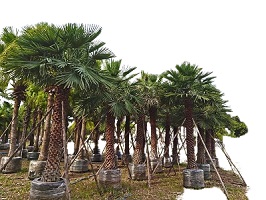Palm Tree Root Benefits: Root System of Palm Trees
Palm Tree Root Benefits: Root System of Palm Trees
The roots of a palm tree are an important part of the tree’s structure since they give it support and nourishment.
The distinctive root system of palm trees makes them stand out from their woody counterparts in contrast to other types of trees.

The absence of secondary development, which is seen in most other plants, is an intriguing characteristic of palm tree roots.
This implies that they will stop growing once they achieve their final length and size.
As a result, during strong winds or heavy rain, palm trees with shallow root systems are more likely to be uprooted or knocked over.
Facts about palm tree roots?
Knowledge gained at various courses in Arizona and southern California has shown that palm tree roots can readily grow over 100 feet from the base of the tree.
Palm plants do not have taproots; instead, they have a fibrous root system.
Types of Palm Tree Roots
Primary roots and lateral or adventitious roots are the two main categories of roots found in palm trees.
On the one hand, primary roots grow from the trunk’s base and penetrate the soil deeply. They are long and dense.
Conversely, lateral or adventitious roots appear from nodes on the stem that are above ground and spread out into the topsoil.
The species and environment of palm trees affect the kind of root system that tree has. Shallow roots are common in areas with sandy soils, where there is limited water availability.
These particular palms have adapted to the environment by developing shallow root systems that can swiftly absorb moisture from irrigation or rainfall.
They are, however, also more vulnerable to wind damage during hurricanes or other storms as a result of this.
On the other hand, palm trees that thrive in environments rich in nutrients and water tend to have deep root systems.
These particular palms may bury themselves up to 20 feet beneath the surface of the ground, giving them access to a larger variety of water and nutrients.
How Do Palm Tree Roots Grow?
It’s important to understand how a palm tree’s root system works if you’re thinking about putting one in your landscaping.
How far down should your palm be planted? When planting palm trees, should the roots be pruned? Will the roots harm the foundation of your house?
Palm trees have very different root systems than other types of trees. They develop from a particular spot at the plant’s base and are thick and fibrous. Palm roots also continuously regenerate and replace one another.
Palms are able to support themselves exceptionally effectively in settings where other trees would struggle thanks to their unique root systems.
Nutritional value
It is very nutrient-dense and a significant dietary fiber source. It contains a lot of zinc, which shortens the time it takes for wounds to heal.
The heart of palm is high in vitamins K and A, which are necessary for a healthy scalp and hair.
Additionally, it has a lot of beta carotene, which helps to enhance vision?
Palm tree roots benefits ~ what is the benefit of palm fruit root?
The palm fruit is excellent for alleviating stomach burning. Use palm fruit to keep your body hydrated during the summer.
It restores the body’s depleted minerals and nutrients, reduces unpleasant urination, and alleviates fatigue.
Lastly, it is successfully used to treat digestive issues and other gastrointestinal conditions.
Root System of Palm Trees
The monocot order Arecales contains perennial blooming plants in the Arecaceae family, which includes palms.
Palms can develop as stemless plants, climbers, shrubs, and trees. In tropical and subtropical areas of the world, it is common to see huge, compound, evergreen fronds on top of an unbranched trunk.
Africa, Asia, Central America, South America, and the Pacific islands are all common places to find them.
Roots of Palm Tree
Compared to other tree species, the roots of palm trees exhibit some highly unique traits. Palm trees have a ‘fibrous root system.’
The palm’s roots are not firmly embedded in the ground. Nearly 36 inches of topsoil are penetrated as they are spread out like a mat across the ground.
Even if the tree is placed in shallow soil, we can still see these roots. Sandier soil is preferred by the roots of palm trees, which makes them simple to remove.
This explains why most palm trees are knocked over by severe winds.
The roots of palm trees grow from the base of the tree and are morphologically similar to the taproot system found in most tree species, which has one main root from which the thin lateral roots emerge.
These roots develop with the same girth no matter how old or long the palm tree is; they do not get wider as the tree gets longer.
Can Roots of the Palm Tree damage underground pipes?
It is frequently observed that many trees’ broad, thick roots lift concrete and harm subsurface pipes.
However, neither the concrete nor the underground pipes are harmed by the roots of palm trees in the same way.
The explanation is that the roots of the palm trees do not reach the pipes because they remain in the topsoil surrounding them.
Additionally, because these roots are shallow, they rarely harm the concrete. But occasionally, the roots get to the underground pipes and mess with them.
Maintenance of Palm Tree Roots
Although palm trees are primarily located in tropical and subtropical areas of the world, if we are sufficiently knowledgeable about the type of palm tree and the size of its roots, we can easily plant one in our backyard.
Nevertheless, it is essential to pay close attention to the tree.
The roots of the Plam trees require moisture and nutrients to feed both their huge fronds and long, thick trunks.
So, once you’ve planted a palm tree, be careful to water it regularly to meet its water needs.
You can wrap a soaker hose around the root area to keep the soil moist, which will ensure that the roots’ water needs are met.
Worldwide, there are 2600 different species of palm trees. There are many different types of palm trees, but some of the most common ones are the following:
The coconut palm tree (Cocos nucifera), the date palm (Phoenix dactylifera), the areca palm (Dypsis lutescens), the queen palm (Syagrus romanzoffiana), the African oil palm (Elaeis guineensis), the California palm (Washingtonia filifera), and the Mexican
Functions of Palm Tree Roots
Given that palm trees have long trunks and enormous fronds, their roots play a significant role in maintaining the moisture and nutrition of these structures.
Let’s go through some of the crucial duties performed by a palm tree’s roots.
- To keep the palm tree hydrated, the roots of palm trees take moisture from the earth around them.
- They carry the absorbed water and nutrients up the length of the trunk and to the fronds to maintain them green and fresh.
- They also absorb dissolved minerals in the form of magnesium, iron, and manganese, which are important to prevent the fronds from yellowing.
- The lengthy trunk of Plam Trees is stabilized and anchored by these roots.
- By firmly grasping the soil particles with the roots, these fibrous roots are in charge of tying the sandy soil surrounding them together.
- Urinary tract infections, gallbladder issues, and other renal issues can all be treated with palm tree roots. When the water has cooled off after being boiled with four to five roots, consume it.
- Boiling 3-5 finger-long pieces of roots and drinking them for a few days is necessary for those with fibrosis.
- It aids in thawing the clots of blood. Heartburn can also be treated with the roots of palm trees.
Questions People also ask about Palm Tree Root
What can you do with palm tree roots? Uses of palm tree roots?
Urinary tract infections, gallbladder issues, and other renal issues can all be treated with palm tree roots.
When the water has cooled off after being boiled with four to five roots, consume it. Boiling 3-5 finger-long pieces of roots and drinking them for a few days is necessary for those with fibrosis.
What are some facts about palm tree roots?
My experience in various courses in Arizona and southern California has shown that palm tree roots can readily stretch over 100 feet from the base of the tree.
However, unlike other trees, palm trees do not have a taproot.
What benefits do palm trees have for health? The medicinal value of palm root tree;
However, the oil’s regular use as a foundation for preparing medications like cough syrups is a significant benefit.
Additionally, it has been linked to a high vitamin A intake, which lowers cholesterol levels and lowers the risk of developing serious diseases including cancer and heart disease.
What are palm roots called?
These are the roots that take up nutrients and water.
In some species such as Phoenix spp., the specialized roots known as pneumatophores may literally shoot upward and out of the ground.
Unlike dicot roots, palm roots lack root hairs.
What are the problems with palm tree roots?
The palm tree’s roots pose a serious threat to public safety since they have the capability to intrude on and damage electricity lines.
This could necessitate costly repairs and raise the risk of fire or water damage to your house. Invasive palm root trees have the potential to colonize a landscape.
Why did Jesus use palm trees?
When Jesus entered Jerusalem triumphantly on Palm Sunday, the early Christians used the palm branch as a symbol of the faithful’s victory over spiritual foes.
Which part of the palm tree is useful?
Leaves are used in numerous domestic economies whereas trunks are used in building and furniture manufacturing.
The African oil palm is significant primarily for the kernel oil from the seed and the palm oil obtained from the fruit coat.
Both the Old and New Worlds make considerable use of other palms.
What is the importance of palm trees in Nigeria? Palm Tree Root
In rural places, palm leaves are used to build roofing sheets (thatch roofs), raffia mats, fences, and village bathrooms.
Additionally, farm animals like sheep and goats are fed on palm leaves. The trunk of a palm tree produces exceptionally sturdy wood that is occasionally sawn into planks and used to construct benches.
Can palm roots be eaten?
When young trees are harvested, they are fallen and their bark is removed to reveal their edible, white inner core, which is then divided into lengths for processing.
Heart of Palm can be used as a vegan meat substitute and is most frequently added to salads, although it can also be eaten on its own.
The palm tree is known as the “tree of life,” but why?
The “Tree of Life” moniker for the coconut palm refers to its role in human survival.
The coconut tree is used for more than just food and drink; it also serves as a source of shelter, fuel, and raw materials for making utensils, musical instruments, and other items.
What are the deep roots of the palm tree?
Palm tree roots like to spread out horizontally as opposed to growing straight down as most tree roots do.
The topsoil area, typically not deeper than 12 to 36 inches, is where the roots will extend out.
In an effort to assimilate as much water and nutrients as possible, the roots will expand out from the tree’s trunk.
What tree has the most extensive roots?
The Kalahari Desert’s native shepherd’s tree (Boscia albitrunca) has the deepest known roots, measuring more than 70 meters (230 ft) underground.
By mistake, groundwater well drillers learned of their depth. The tips of plant roots are comparable to the brains of plants, according to a statement made by Charles Darwin.

What are some facts about palm trees in the Bible?
The Christian celebration of Palm Sunday commemorates Jesus’ triumphal entry into Jerusalem when the people “took palm branches and went out to meet Him,” according to the Gospel of John (12:13 HCSB).
Uses for palm tree roots in medicine ~ Palm Tree Root
For a significant portion of recorded history, the Maldives’ traditional medicines have made frequent use of the root of coconut palms.
The roots are and were used as a remedy for fever, diarrhea, and urinary problems.
Benefits of chewing coconut root
For a significant portion of recorded history, the Maldives’ traditional medicines have made frequent use of the root of coconut palms.
The roots are and were used as a remedy for fever, diarrhea, and urinary problems. But its remarkable ability to treat skin conditions is perhaps best known.
Health benefits of palm trees
Overview. The fruit of the oil palm tree is where palm oil is found.
Palm oil is used to cure malaria, high blood pressure, high cholesterol, and cyanide poisoning in addition to avoiding vitamin A deficiency, cancer, brain disease, and aging.
Palm oil is utilized to accelerate metabolism and lose weight.
Benefits of palm fruit
The water-soluble phenolic-flavonoid-rich antioxidant complex is a relatively recent product of the oil palm fruit.
This contains strong antioxidant capabilities and is also effective in preventing malignancies of the skin, breast, and other types.
5 uses of palm tree
Numerous food sources, drinks, insulation, oil, lumber, woven fabrics, and other products can all be made from palm trees.
Palm trees are valuable resources that are frequently used for a wide variety of these uses in different areas.
They are not only very helpful but also a lovely sight.
Benefits of palm trees at home
The most well-known thing we may obtain from palm trees is reportedly palm oil. It is a type of cooking and frying oil that is obtained from the fruit of the palm tree.
In addition to being safe and nutritious for human nutrition, it is employed industrially to make cosmetics, soaps, toothpaste, lubricants, inks, and waxes.
10 uses of palm tree
It can be utilized as fuel, food, shelter, building materials, and even as a source of fuel.
In many regions of the world, palm fruit is a widely consumed food. It can be dried, cooked, or eaten raw.
Additionally, the fruit’s oil can be utilized in cooking and as a moisturizer for the skin.
Can palm tree roots regrow?
The plant will eventually start to grow root above ground. These roots frequently dry down or desiccate, and stop growing.
These roots can resume growing and eventually reach the ground, though, if conditions are right.


